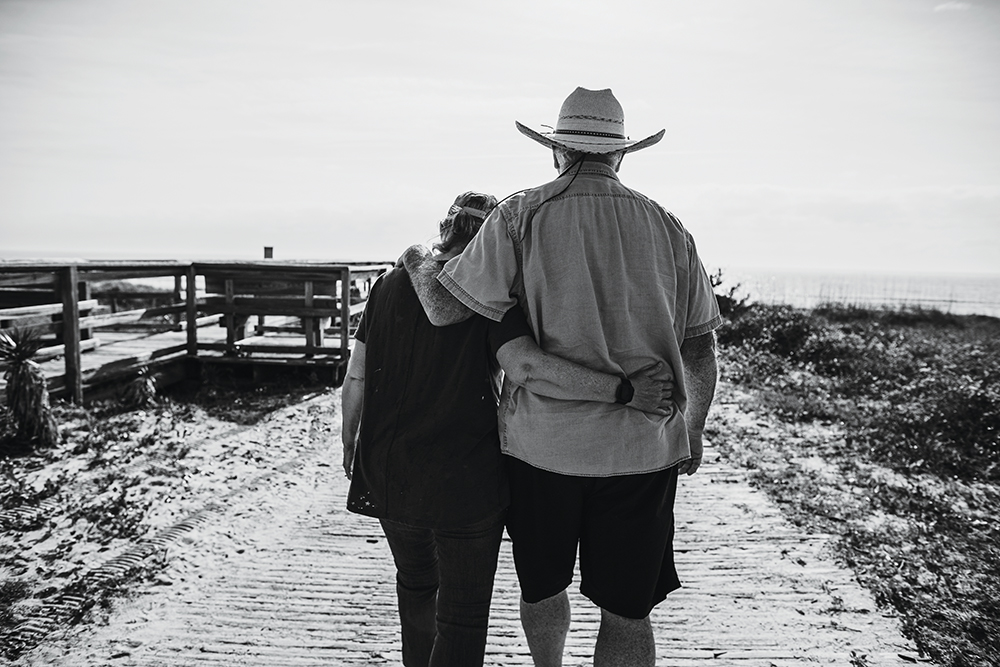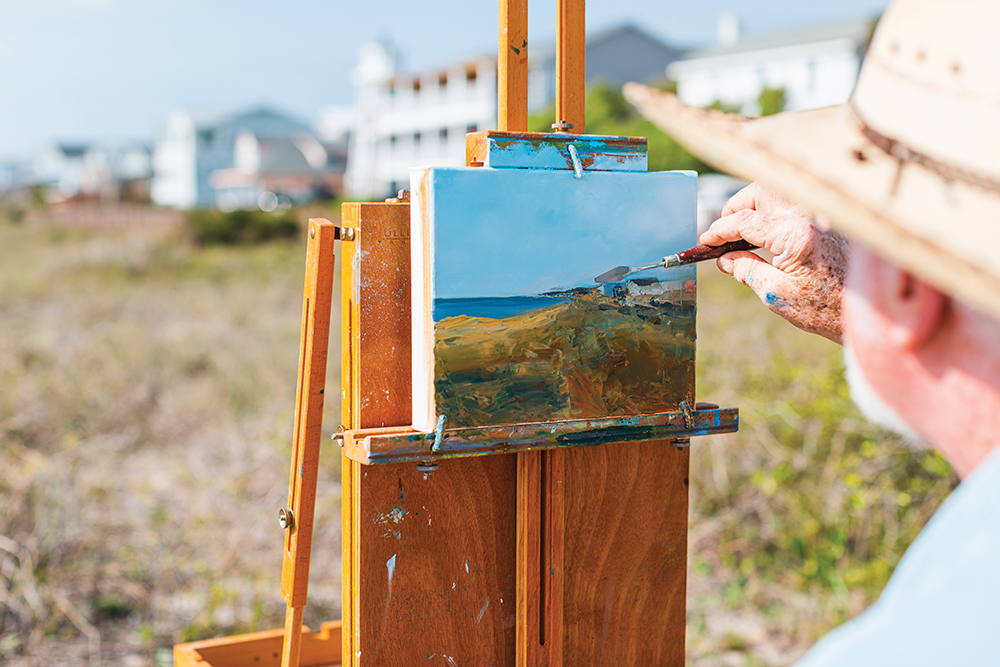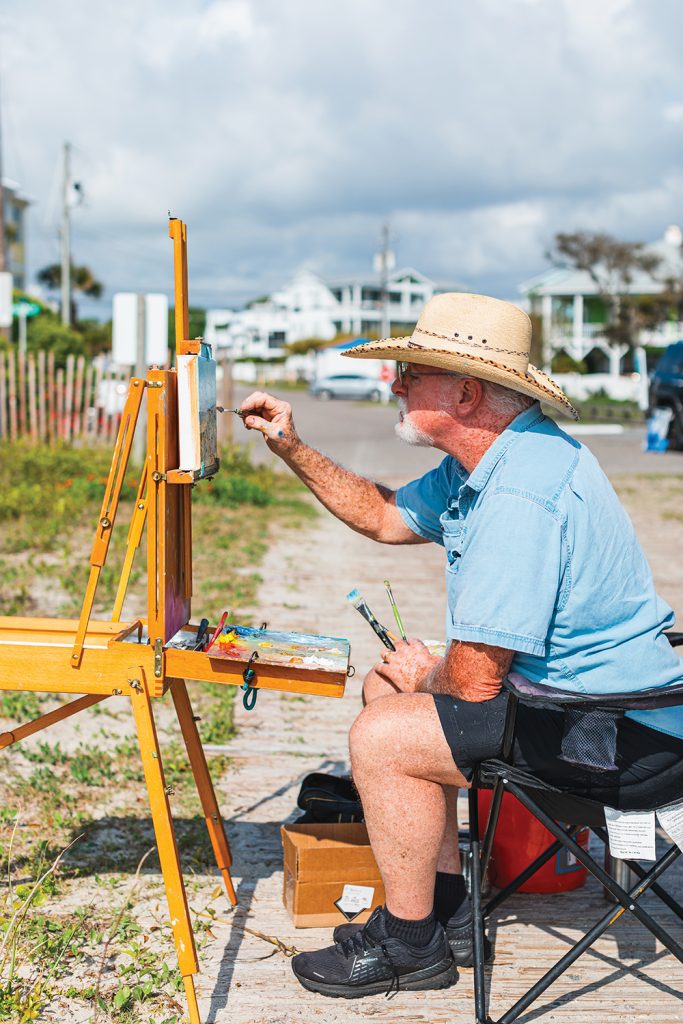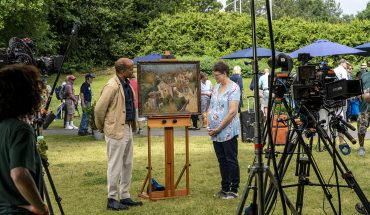As his body started to deteriorate from ALS, this artist and former marine moved from Durham to Wilmington to live out his life by the beach.
by Wiley Cash | photography by Mallory Cash
In 2013, painter Tom Ward went to the beach to die. He and his wife Mary, both natives of Long Island, New York, had been living in Durham for 11 years when he was diagnosed with amyotrophic lateral sclerosis, more commonly known as ALS, a disease that affects the nerve cells in the brain and spinal cord. Over time, people with ALS lose control of their muscles, including the muscles used to eat, speak and breathe. Most die of respiratory failure within three to five years.
“I didn’t know how long I was going to live,” Tom says one afternoon in late May while we are sitting in his living room in Wilmington, several of the gorgeous paintings he’s completed over the years hanging on the walls around us. He smiles a wry smile. “And I kept thinking, It’ll be too bad if I croak in Durham — we’re beach people!”

Mary and Tom Ward in Wilmington
“We love the beach,” he says. “When we were young and dating, even after we were married, we spent a lot of time on the Long Island beaches on the South Shore and the North Shore. So when I got the diagnosis we came out to Wilmington and looked around. And that’s how we got here.”
Only 10 percent of those diagnosed with ALS live beyond a decade, and Tom can be counted among those few. His disease is mercifully slow moving, and some days he feels well enough to take a trip to the beach with Mary’s assistance to paint on the shore; Fort Fisher is a favorite spot.
Other days, when his body does not feel like his own, he works from home, taking his motorized wheelchair into his studio, where he moves onto a padded chair positioned in front of his easel. Throughout his battle with ALS and its attendant and unpredictable ups and downs, painting has been a constant in Tom’s life. So has Mary’s support and advocacy.
In 2016 Mary was named a fellow by the Elizabeth Dole Foundation, whose mission it is to empower and support the military caregivers who care for America’s ill, wounded or injured veterans. A former Marine, Tom, like other veterans, is two times more likely than a civilian to develop ALS. Mary has spent years advocating for caregivers like herself and for veterans like Tom, even authoring three books on issues from navigating veterans benefits to service dogs to her own’s family’s experiences with war after the couple’s son served in Iraq and Afghanistan.
But it’s not in her national efforts that Mary’s support for Tom is most apparent. It is more evident in the small moments of their day-to-day lives: her leaving the conversation to get him a glass of water; her gently correcting his memory or assisting him as he parses the details of one of my questions. And Tom is just as devoted to Mary as she is to him, supporting her through two graduate degrees and careers as a public school teacher and a hospital administrator. It was the latter position that caused the couple to move from New York to Durham, after she accepted a job at Duke Hospital.
But as much as their relationship is based on intangible evidence of love and support, the larger moments still loom in their shared past, perhaps none larger than the moment in 1993, after 13 years of marriage, when Tom contracted encephalitis and, after a lengthy treatment, showed signs of cognitive impairment that affected his executive functions.
Suddenly, a man who’d served in the military and forged a career in risk management for an insurance company in Manhattan was having trouble parsing step-by-step instructions and remembering simple tasks, like picking up their 9-year-old daughter and 10-year-old son from school. Tom’s symptoms forced him to retire from a busy job, and he suddenly found himself without purpose for the first time in his life.
“When our kids were growing up, I had to appear to them to be industrious in some way,” he says. “That was just my personal rule. I couldn’t sit on the couch and give into the thing and let that thing rule me, let the fatigue rule me.”
A year or so into Tom’s battle with the long-term symptoms of encephalitis, he and Mary found themselves in an art gallery not far from their home in upstate New York. Tom had always appreciated art, but he didn’t know much about it.
“I thought all painting was called impressionism,” he says, laughing. “I didn’t know there was something called classical realism or other styles of painting. I thought impressionism meant painting like someone would think all cars are Chevys without knowing about Buicks or Pontiacs or Peugeots.”
Even though Tom didn’t know much about painting, that day in the gallery he couldn’t help but be struck by the work of an artist who signed their paintings “V. Walsh.” Tom approached the gallery owner and learned that V. Walsh was a woman named Virginia. On impulse, Tom expressed an interest in studying under Walsh, and he left his phone number with the gallery owner. Within a few weeks he and Virginia Walsh were setting up their easels side-by-side, a master and an apprentice with zero experience.

I ask Tom what drew him to Walsh’s work, what it was about her paintings that day in the gallery that caused him to make a decision that would change his life.
“She turned a form,” he says, referring to a painter’s ability to give the illusion of depth on a flat surface. “It was a painting of a plum that had a quarter sliced out, and the slice was laying as a half moon shape on a tabletop. It was the light striking the flesh of the plum and the color that she put there. And then you could see the interior of the plum where the slice had been removed. Her use of color was just so perfect. It just grabs the eye. That’s what made me say, Wow, that’s it. I want to do that.”
Toms’ work under Walsh got off to a rocky start. It was Walsh’s practice to educate by example, and she and Tom would regularly set up their easels and paint en plein air together for hours at a time. She was particular in the way she wanted his paints and materials organized, but, to her frustration, Tom seemed unwilling to comply.
Walsh ended up calling Mary in frustration to break the news that she couldn’t work with Tom because of his obstinate disposition. When Mary discovered that Tom hadn’t shared his struggles with executive function with his new mentor, she told the teacher that her pupil wasn’t being obstinate; he simply didn’t have the ability to comply without explicit, patient direction.
Things went more smoothly after that, and Walsh and Tom continued to work together, painting outdoors through a number of seasons to exhibit for Tom the exquisite changes in the natural world.
Both his attention to detail and his deeply felt portrayals of the natural world are evident in Tom’s work almost 30 years after his lessons with Virginia Walsh, though sometimes his ALS makes it difficult for him to render detail as easily as he once could. Take the use of his palette knife when he works with it, rather than a brush, to apply a smooth layer of paint to the canvas.
“I’m just not getting the cut of the knife in a way that portrays what I’m seeing in my mind,” he says. “That’s ALS. The thought in my brain that tells my hand what to do either gets lost completely or is received in a garbled fashion. So my hand’s not really doing what I’m asking it to do.”
But, just as he has throughout his life, whether as a Marine or a businessman or a new painter struggling with organizing his paints and materials, Tom finds a way to adapt. And, as usual, Mary is by his side. No matter what comes next, it will happen to them together. And it will happen by the sea.
This article originally appeared in the July 2023 issue of WALTER magazine.





